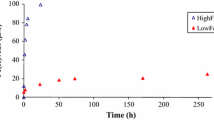Abstract
Sulfate-reducing bacteria and their by-products, such as iron sulfides, are widely distributed in groundwater and sediments, and can affect subsurface aqueous chemistry. Here we show the catalytic reduction of hexavalent uranium by FeS particles, which were largely generated by the activities of Desulfovibrio desulfuricans and D. vulgaris in anaerobic condition. Characterization of FeS particles by X-ray diffraction and high-resolution transmission electron microscopy revealed the presence of mackinawite having thin and flexible platy sheets with 0.5-nm lamellar spacing. This biogenic phase mediated abiotic reduction of U(VI) to U(IV) which was confirmed by UV–Vis absorption spectroscopy. The U conversion occurred through surface catalysis that involved adsorption of aqueous U(VI)–carbonate complexes (predominantly UO2(CO3) 4−3 ) onto the mackinawite, but the transformed uranium was then released and remained in suspended form in the solution phase. This surface catalysis and subsequent U(IV) remobilization has not been reported as a pathway to occur under sulfate-reducing conditions. Our results suggest that the iron sulfide solid, which is characteristic of conductive property, is very sensitive and variable depending on the electron supplying and transferring environment, negatively affecting the surface uranium to be strongly stabilized and fixed on the FeS surface.







Similar content being viewed by others
References
Lloyd JR, Renshaw JC (2005) Curr Opin Biotechnol 16:254–260
Francis AJ (2007) J Alloys Compd 444–445:500–505
Lovley DR, Phillips EJP (1992) Environ Sci Technol 26:2228–2234
Madrakian T, Afkhami A, Rahimi M (2012) J Radioanal Nucl Chem 292:597–602
Gao L, Yang Z, Shi K, Wang X, Guo Z, Wu W (2010) J Radioanal Nucl Chem 284:519–526
Yi Z, Lian B (2012) J Radioanal Nucl Chem 293:321–329
Lovley DR, Phillips EJP, Gorby YA, Landa ER (1991) Nature 350:413–416
Abdelouas A, Lu Y, Lutze W, Nuttall HE (1998) J Contam Hydrol 35:217–233
Fredrickson JK, Zachara JM, Kennedy DW, Liu C, Duff MC, Hunter DB, Dohnalkova A (2002) Geochim Cosmochim Acta 66:3247–3262
Boyanov MI, Fletcher KE, Kwon MJ, Rui X, O’Loughlin EJ, Löffler FE, Kemner KM (2011) Environ Sci Technol 45:8336–8344
Gorby YA, Lovley DR (1992) Environ Sci Technol 26:205–207
Abdelouas A, Lutze W, Gong W, Nuttall EH, Strietelmeier BA, Travis BJ (2000) Sci Total Environ 250:21–35
Benning LG, Wilkin RT, Barnes HL (2000) Chem Geol 167:25–51
Renock D, Gallegos T, Utsunomiya S, Hayes K, Ewing RC, Becker U (2009) Chem Geol 268:116–125
Gramp JP, Bigham JM, Jones FS, Tuovinen OH (2010) J Hazard Mater 175:1062–1067
Sani RK, Peyton BM, Amonette JE, Geesey GG (2004) Geochim Cosmochim Acta 68:2639–2648
Liger E, Charlet L, Cappellen PV (1999) Geochim Cosmochim Acta 63:2939–2955
Davies W, Gray W (1964) Talanta 11:1203–1211
Moyes LN, Parkman RH, Charnock JM, Vaughan DJ, Livens FR, Hughes CR, Braithwaite A (2000) Environ Sci Technol 34:1062–1068
Livens FR, Jones MJ, Hynes AJ, Charnock JM, Mosselmans JFW, Hennig C, Steele H, Collison D, Vaughan DJ, Pattrick RAD, Reed WA, Moyes LN (2004) J Environ Radio 74:211–219
O’Loughlin EJ, Kelly SD, Kemner KM (2010) Environ Sci Technol 44:1656–1661
Veeramani H, Alessi DS, Suvorova EI, Lezama-Pacheco JS, Stubbs JE, Sharp JO, Dippon U, Kappler A, Bargar JR, Bernier-Latmani R (2011) Geochim Cosmochim Acta 75:2512–2528
Marshall MJ, Beliaev AS, Dohnalkova AC, Kennedy DW, Shi L, Wang Z, Boyanov MI, Lai B, Kemner KM, McLean JS, Reed SB, Culley DE, Bailey VL, Simonson CJ, Saffarini DA, Romine MF, Zachara JM, Fredrickson JK (2006) PLoS Biol 4:1324–1333
Payne RB, Casalot L, Rivere T, Terry J, Larsen L, Giles BJ, Wall JD (2004) Archiv Microbiol 181:398–406
Lee SY, Baik MH, Choi JW (2010) Environ Sci Technol 44:8409–8414
Wersin P, Hochella MF, Persson P, Redden G, Leckie JO, Harris DW (1994) Geochim Cosmochim Acta 58:2829–2843
Scott TB, Riba TO, Allen GC (2007) Geochim Cosmochim Acta 71:5044–5053
Anderson RT, Vrionis HA, Ortiz-Bernad I, Resch CT, Long PE, Dayvault R, Karp K, Marutzky S, Metzler DR, Peacock A, White DC, Lowe M, Lovley DR (2003) Appl Environ Microbiol 69:5884–5891
Lovley DR, Phillips EJP (1992) Appl Environ Microbiol 58:850–856
Bargar JR, Bernier-Latmani R, Giammar DE, Tebb BM (2008) Elements 4:407–412
Acknowledgments
We thank Dr. Arokiasamy J. Francis and Dr. Wooyong Um for his helpful discussions and reviews on this manuscript. This work was supported by the Nuclear Research and Development Program of National Research Foundation of Korea (NRF) funded by the Ministry of Education, Science and Technology (MEST).
Author information
Authors and Affiliations
Corresponding author
Rights and permissions
About this article
Cite this article
Lee, S.Y., Baik, M.H., Cho, HR. et al. Abiotic reduction of uranium by mackinawite (FeS) biogenerated under sulfate-reducing condition. J Radioanal Nucl Chem 296, 1311–1319 (2013). https://doi.org/10.1007/s10967-013-2438-6
Received:
Published:
Issue Date:
DOI: https://doi.org/10.1007/s10967-013-2438-6




